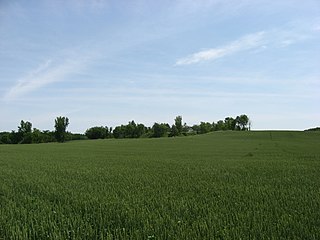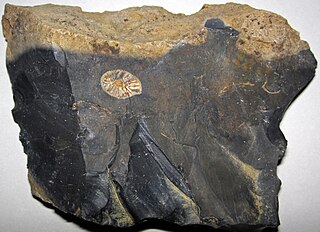Related Research Articles

In North American archaeological terminology, a projectile point is an object that was hafted to a weapon that was capable of being thrown or projected, such as a javelin, dart, or arrow. They are thus different from weapons presumed to have been kept in the hand, such as knives, spears, axes, hammers, and maces.

Clovis points are the characteristically fluted projectile points associated with the New World Clovis culture, a prehistoric Paleo-American culture. They are present in dense concentrations across much of North America and they are largely restricted to the north of South America. There are slight differences in points found in the Eastern United States bringing them to sometimes be called "Clovis-like". Clovis points date to the Early Paleoindian period, with all known points dating from roughly 11,500 to 10,800 years Before Present. Clovis fluted points are named after the city of Clovis, New Mexico, where examples were first found in 1929 by Ridgely Whiteman.

Folsom points are projectile points associated with the Folsom tradition of North America. The style of tool-making was named after the Folsom site located in Folsom, New Mexico, where the first sample was found in 1908 by George McJunkin within the bone structure of a bison, an animal hunted by the Folsom people in New Mexico. The Folsom point was identified as a unique style of projectile point in 1926.

The Plano cultures is a name given by archaeologists to a group of disparate hunter-gatherer communities that occupied the Great Plains area of North America during the Paleo-Indian or Archaic period.
The old Cordilleran culture, also known as the Cascade phase, is an ancient culture of Native Americans that settled in the Pacific Northwestern region of North America that existed from 9000 or 10000 BC until about 5500 BC.
The .408 Cheyenne Tactical is a specialized rimless, bottlenecked, centerfire cartridge for military long-range sniper rifles that was developed by Dr. John D. Taylor and machinist William O. Wordman. The round was designed with a possible military need for a cartridge for anti-personnel, anti-sniper, and anti-materiel roles with a (supersonic) precision range of 2,200 yards. It is offered as a competitor to the most common military NATO long-range service cartridges such as .338 Lapua Magnum and the .50 BMG.

The Glacial Kame culture was a culture of Archaic people in North America that occupied southern Ontario, Michigan, Ohio, and Indiana from around 8000 BC to 1000 BC. The name of this culture derives from its members' practice of burying their dead atop glacier-deposited gravel hills. Among the most common types of artifacts found at Glacial Kame sites are shells of marine animals and goods manufactured from a copper ore, known as float copper.
A Cascade point is a projectile point associated with the Cascade phase, an ancient culture of Native Americans that settled in the Pacific Northwest that existed from 9000 or 10000 BC until about 5500 BC.
Eden Points are a form of chipped stone projectile points associated with a sub-group of the larger Plano culture. Sometimes also called Yuma points, the first Eden points were discovered in washouts in Yuma County, Colorado. They were first discovered in situ at an ancient buffalo kill site near Eden, Wyoming by Harold J. Cook in 1941. The site, named after discoverer O. M. Finley, eventually yielded 24 projectile points, including eight Eden points, eight Scottsbluff points and one complete Cody point, both other sub-groups within the Plano group. Eden points are believed to have been used between 10,000 and 6,000 years ago by paleo-indian hunters in the western plains.

The Eva site (40BN12) is a prehistoric Native American site in Benton County, Tennessee, in the Southeastern United States. Located along an ancient channel of the Tennessee River, the Eva site saw extensive periods of occupation during the Middle and Late Archaic period. The site's well-defined midden layers helped investigators identify three distinct Archaic cultures, the oldest of which was first identified at Eva and is still known as the "Eva culture" or the "Eva phase."
Prehistory of Colorado provides an overview of the activities that occurred prior to Colorado's recorded history. Colorado experienced cataclysmic geological events over billions of years, which shaped the land and resulted in diverse ecosystems. The ecosystems included several ice ages, tropical oceans, and a massive volcanic eruption. Then, ancient layers of earth rose to become the Rocky Mountains.

Lamoka projectile points are stone projectile points manufactured by Native Americans what is now the Northeastern United States, generally in the time interval of 3500-2500 B.C. They predate the invention of the bow and arrow, and are therefore not true "arrowheads", but rather atlatl dart points. They derive their name from the specimens found at the Lamoka site in Schuyler County, New York.

The LoDaisKa site is a prominent archaeological site in the U.S. state of Colorado, located within a rockshelter near Morrison. The rockshelter was first inhabited by people of the Archaic through the Middle Ceramic period, generally spanning 3000 BC to 1000 AD.

In the classification of Archaeological cultures of North America, the term Plainview points refer to Paleoindian projectile points dated between 10,000 and 9,000 Before Present. The point was named in 1947 after the discovery of a large cache of unfluted, lanceolate spear tips with concave bases that were found in a Bison antiquus kill site along the Running Water Draw river, near the town of Plainview in Texas, United States. The point is found primarily throughout the South Plains, however, this range may sometimes be misidentified, as "Plainview" was previously used as a general term to describe unfluted lanceolate points throughout the entirety of the Plains, as well as the eastern Upper Mississippi Valley.

The Cody complex is a Paleo-Indian culture group first identified at a bison antiquus kill site near Cody, Wyoming in 1951. Points possessing characteristics of Cody Complex flaking have been found all across North America from Canada to as far south as Oklahoma and Texas.

The following outline is provided as an overview of and topical guide to the prehistoric people of Colorado, which covers the period of when Native Americans lived in Colorado prior to contact with the Domínguez–Escalante expedition in 1776. People's lifestyles included nomadic hunter-gathering, semi-permanent village dwelling, and residing in pueblos.
Hell Gap complex is a Plano culture from 10,060 to 9,600 before present. It is named after the Hell Gap archaeological site, in Goshen County, Wyoming.
Hell Gap is a deeply stratified archaeological site located in the Great Plains of eastern Wyoming, approximately thirteen miles north of Guernsey, where an abundant amount of Paleoindian and Archaic artifacts have been found and excavated since 1959. This site has had an important impact on North American archaeology because of the large quantity and breadth of prehistoric Paleoindian and Archaic period artifacts and cultures it encompasses. It was designated a National Historic Landmark in 2016.

Plano ISD Academy High School, commonly referred to as Academy High School, is a STEAM, interdisciplinary and project-based learning high school. The school serves students from grades 9-12. This school is not a regular secondary school because this school uses a selection process to draw eighth graders from various middle schools in Plano ISD. The school is an alternative to the regular high school experience by offering collaborative team projects, more STEAM classes and the ability to attend classes without structured class periods. This school is one of the three Academy Programs in Plano ISD. The others are the Plano ISD Health Sciences Academy and The IB World School at Plano East.

The Welling site is an archaeological site of the Paleo-Indian period, meaning the time of the earliest humans. Located in Coshocton County, Ohio, it was a site for quarrying stone in the Upper Mercer chert source area. Based upon the microwear analysis of stone tools, it is believed to be a base camp where people learned and shared Clovis tool-making techniques, ate, exchanged information, and perhaps found mates from others groups.
References
- ↑ Davis, Loren G. (6 November 2013). "Evolution of Projectile Points". Idaho Cultural Resources. Boise: Department of the Interior, Bureau of Land Management. Archived from the original on 27 September 2012. Retrieved 27 December 2013.